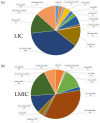Norovirus Infections and Disease in Lower-MiddleandLow-Income Countries, 1997⁻2018
- PMID: 30974898
- PMCID: PMC6521228
- DOI: 10.3390/v11040341
Norovirus Infections and Disease in Lower-MiddleandLow-Income Countries, 1997⁻2018
Abstract
Noroviruses are a major cause of viral gastroenteritis. The burden of the norovirus in lowresourcesettings is not well-established due to limited data. This study reviews the norovirusprevalence, epidemiology, and genotype diversity in lower-middle-income countries (LMIC) andin low-income countries (LIC). PubMed was searched up to 14 January 2019 for norovirus studiesfrom all LIC and LMIC (World Bank Classification). Studies that tested gastroenteritis cases and/orasymptomatic controls for norovirus by reverse transcription-polymerase chain reaction (RT-PCR)were included. Sixty-four studies, the majority on children <5 years of age, were identified, and 14%(95% confidence interval; CI 14-15, 5158/36,288) of the gastroenteritis patients and 8% (95% CI 7-9,423/5310) of healthy controls tested positive for norovirus. In LMIC, norovirus was detected in 15%(95% CI 15-16) of cases and 8% (95% CI 8-10) of healthy controls. In LIC, 11% (95% CI 10-12) ofsymptomatic cases and 9% (95% CI 8-10) of asymptomatic controls were norovirus positive.Norovirus genogroup II predominated overall. GII.4 was the predominant genotype in all settings,followed by GII.3 and GII.6. The most prevalent GI strain was GI.3. Norovirus causes a significantamount of gastroenteritis in low-resource countries, albeit with high levels of asymptomaticinfection in LIC and a high prevalence of coinfections.
Keywords: GII.4; genotype diversity; lower‐middle‐income countries; low‐income countries; norovirus; systematic review.
Conflict of interest statement
The author declares no conflict of interest.
Figures





References
Publication types
MeSH terms
LinkOut - more resources
Full Text Sources
Medical

